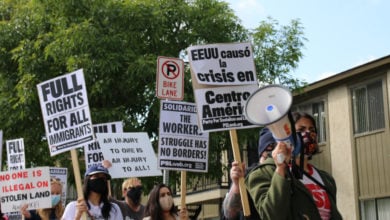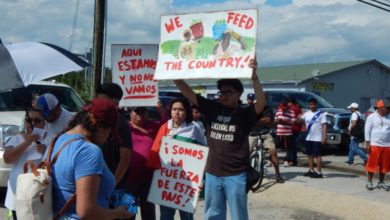Capitalist politicians, far-right organizations and media pundits base their anti-immigrant arguments on the claim that undocumented workers—whom they call “illegal aliens” – have broken the law. They fail to mention that the law has changed, sometimes quite radically, to suit the needs of the capitalist system and in response to political struggles waged by U.S. workers, citizens and non-citizens.
Immigration and citizenship law is not a fixed standard. It has always functioned both as a product of and a producer of institutional racism. It is a way to stigmatize a certain population as “socially undesirable” while at the same time satisfy big business’ need for cheap labor.
Racism and citizenship
The first U.S. citizenship regulation was the 1790 Nationality Act. It gave citizenship to “free white persons” who had resided in the country for two continuous years. Because indentured servants and the propertyless of European descent were not considered “free,” citizenship was highly limited—even for white people. Universal white male suffrage was only won on a state-by-state basis in the early-19th century. White women did not win the right to vote until 1920.
When the United States was formed, people of African descent had been brutally enslaved for over a century. Regardless of their status, freed or slave, they had no citizenship rights.
This policy was upheld by the 1857 Dred Scott Supreme Court decision, which ruled that all people of African descent, free or enslaved, were “beings of an inferior order” and were barred from ever becoming citizens.
The Fourteenth Amendment, passed after the Civil War, formally expanded the right of citizenship to freed slaves and all people born on U.S. soil. In 1870, the Nationality Act expanded this right to include “persons of African nativity or descent.”
Still, African-Americans did not truly win the rights spelled out in the Fourteenth Amendment until the Civil Rights movement of the 1950s and 1960s.
Meanwhile, throughout the 18th and 19th centuries, Native Americans fought a determined struggle for sovereignty and survival against the expansionist U.S. government’s wars of extermination. The citizenship rights guaranteed by the Fourteenth Amendment did not include Native Americans born on tribal lands.
Another significant population was the Mexican people, who were forcibly incorporated into the country by the U.S. war of aggression that stole half of Mexico. In the Mexican-American War of 1846 to 1848, U.S. forces conquered a wide expanse of Mexican territory, including the present U.S. states of Colorado, Arizona, New Mexico, Wyoming, California, Nevada and Utah.
The Treaty of Guadalupe-Hidalgo, which formally ended the war, stipulated that Mexicans who remained in those areas for the next year would automatically become citizens of the United States. The U.S. government systematically violated this right, however.
Early 20th century Mexican immigration
Mexican immigration was numerically insignificant from 1900 to 1909, representing only 0.6 percent of the total immigration into the United States. That number increased slightly to 3.8 percent of total immigration in the following decade.
Mexican laborers primarily took agricultural jobs in the Southwest. Despite the anti-immigrant lobby, growers and industrialists – who extracted super-profits from the Mexicans’ cheap, unskilled labor – testified before Congress of the value of Mexican workers, successfully stalling restrictive legislation.
In part due to this capitalist lobby, the 1924 Immigration Act did not set quotas for immigrants from the Western Hemisphere.
The return of U.S. soldiers from World War I, however, had eliminated the country’s labor shortage, and a 1921 recession exacerbated competition between white and nonwhite workers.
Around this time, press and politicians began to whip up anti-Mexican sentiments. Congress put the “Mexican problem” on the agenda. Every year from 1926 to 1930, Congressmen proposed bills expanding the quotas to the nations of the Western Hemisphere, clearly with Mexico in mind.
The anti-immigration and capitalist pro-immigration lobby employed similar racist stereotypes to make their arguments. Both considered Mexicans a biologically inferior race, with natural tendencies towards docility and ignorance.
The anti-immigration lobby argued that these biological characteristics made Mexicans unfit for U.S. citizenship. Racist sectors of the labor movement claimed these supposed traits were “ruinous” to the U.S. standard of labor. The pro-immigration lobby argued that these very characteristics made Mexican immigrants “harmless” to U.S. society. Furthermore, they argued, Mexicans “did jobs that no one else would take.”
The fact that Mexicans could be naturalized under the Treaty of Guadalupe-Hidalgo posed a problem to the evolving standard of white-only citizenship. On one hand, Mexicans were portrayed as biologically inferior. On the other hand, the mass naturalization of the conquered Mexican population made it impossible to bar Mexicans from citizenship on a legal basis of racial ineligibility.
Faced with these contradictions in their own system, the U.S. capitalist class found common ground with the racist, anti-immigrant lobby. Mexican immigration was driven underground but in practice tolerated.
‘Illegal’ immigration and the Border Patrol
From the late 19th century through the first two decades of the 20th, the Immigration Bureau ignored Mexicans crossing in and out of the Southwestern United States. A pattern of seasonal agricultural employment developed favoring businesses. Immigration inspectors were careful to not disturb this pattern.
At that time, the Southwest was even regarded as the “natural habitat” of the Mexican population. During World War I—again under conditions of a labor shortage – the U.S. Labor Department exempted Mexicans from mandatory taxes and literacy tests. This exemption was lifted in 1919, after the war.
From the end of World War I through the 1920s, U.S. immigration-enforcement policies shifted dramatically. Despite the declaration of “illegal” immigrant populations with the 1882 Chinese Exclusion Act and the introduction of deportations in 1891, few people were actually deported until 1917.
Horrified by the 1917 Russian Revolution, the U.S. capitalist class broadcast the image of the foreign, wild-eyed revolutionary agitator invading U.S. borders to destabilize the nation from within. Congress increased funds for deportation and immigration enforcement. These new restrictions were applied first and foremost to foreign-born communists and anarchists. During the Red Scare of 1919, the U.S. government arrested tens of thousands of radicals. Up to 500 people were deported in that witch-hunt.
This anti-communist campaign was strengthened by the 1921 and 1924 quotas. For the first time, the quotas implied that “illegal” immigration was a danger to national security. The statute of limitations for unlawful entry was lifted entirely.
In 1925, the Immigration Bureau began actively deporting undocumented immigrants. The “illegal” designation was broadly and retroactively applied to all immigrants who had come without documents – even if they came before it was illegal to come without documents.
The U.S. government began to use its administrative apparatus to discourage legal Mexican immigration. The informal, fluid migration that characterized the earlier period was replaced by one in which Mexicans not only took literacy tests and paid a head tax, but also were subjected to humiliating public medical examinations, which included bathing and hair removal. Such procedures were banned with European immigrants.
Legal Mexican immigration dropped from almost 60,000 in 1925 to a little over 3,000 in 1931. By 1929, the U.S. government was deporting 15,000 Mexicans a year. The Border Patrol, made up of Ku Klux Klan members and rancher vigilantes who styled themselves after the Texas Rangers, institutionalized the threat of violence against those who tried to bypass the legal restrictions on immigration.
But this is only half the story.
Deportation as a tactic
Growers still relied on Mexican laborers brought across the border on temporary work visas—similar to the latter-day guest worker programs. Mexicans were brought into the workforce, but not into the citizenry. This immigration policy opened the door to branding the entire community – whether legal or not—with the racist image of the “illegal alien.”
Whereas earlier, passage across the border was routine, now overstaying a 6-month work visa made a Mexican laborer a criminal. This anti-Mexican hysteria culminated in mass deportations during the 1930s. In the midst of the widespread unemployment of the Depression, the U.S. government deported over 400,000 Mexicans and Mexican-Americans—what they called a “voluntary” repatriation program.
Over half of those deported were U.S. citizens.
In 1954, in the midst of an economic boom and the Bracero program—which brought millions of Mexicans into the country as “guest workers” from 1942 to 1964—the U.S. government organized the racist “Operation Wetback,” a massive deportation campaign that expelled over 1 million undocumented immigrants.
Since the 1920s, capitalist politicians have attempted to manipulate the immigration pool, in particular from Mexico, in order to meet the imperialist system’s economic and political needs. They use the tactic of deportation to terrorize the Mexican community and strip it of political and labor rights, and whip up racism to stigmatize Mexicans as an “illegal” people.
Unlike other immigrant groups that came under U.S. rule as a result of imperial conquest, the Mexican community has been systematically and consistently denied political rights around which it could struggle for better working conditions and equality. One grower put it plainly in 1930: “The American negro, the Porto Rican negro [sic], and the Filipinos cannot be deported if they prove later to be a crime menace. The Mexican can be.”
The mass immigrant rights movement that emerged in 2006 is an exciting development in this historic battle for workers’ rights. Experiencing a century of discriminatory, racist immigration policy, millions of immigrants—the Mexican community in particular—have taken to the streets and demanded the full rights they have long been owed.




